How to Draw a Tree Oak Tree
About Vincent Whitehead
 My life has been influenced over the years by many things. First is my fundamental belief in God and second my family and the rural up-bringing that I have had. These two basic values have guided me and given me a love for nature, history, and the country life style.
My life has been influenced over the years by many things. First is my fundamental belief in God and second my family and the rural up-bringing that I have had. These two basic values have guided me and given me a love for nature, history, and the country life style.
I have always loved to draw and paint but, in 1996, I decided that it was more than just a hobby for me. I was not happy with the occasional sketch or quick scribble. I began seriously considering the world around me and then working out the God given talent toward a perfecting of a personal style so that I could render the scenes that I so dearly love. It is that perfecting process that has guided me to where I am now. No, I have not arrived. Nor have I attained perfection. On the contrary, I believe my journey has merely served to push me on toward the mark. It has given me feelings of accomplishment and greatened my respect for God's creation.
Follow this link to visit Vincent's Website
How to Draw an Oak Tree (Deciduous) with Pen & Ink
(Click Images for Larger View)
As we have now finished the tutorials based on the Gilbert Home Portrait, it is time to start the one based on a large old Oak, featured in the "Between Two Trees" drawing of the Elwer Family Barn and property.
If you have worked through the tutorials from the "Gilbert Home Portrait" you will have found that the tree bark work is accomplished by using a series of lines, squiggles, dots (called stipple work) and tone work done by a "drag method" I have developed, in a layering process that produces a believable rendering. The layers build depth and tone and can yield values in as many as 7 strengths. The process requires patience and a very light touch but can produce very believable trees.
The main tree in the "Gilbert Home Portrait" was a Maple. This tree, an Oak, has a coarse bark and has wonderful characteristics. The Oak that we will now cover has even more character and depth than the maple. This old Oak has been on the property for ever it seems. I choice to do this drawing originally because of this tree and then heard that the barn was to be taken down. Once I heard that, I decided to take a look at it again and eventually decided I could draw the trees I liked and place the barn in the background as it set in real life. That's what I did.
Part 1 – Let's get started…
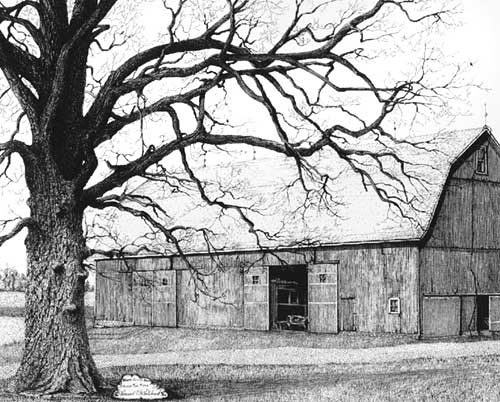
As with the beginning work on the tree from the Gilbert Home property, I start with a light pencil sketch or outline of the old oak, you can see this from the Layout image compared to the Oak Tree reference:
| With the fine point pen, I ensure that I have good ink flow on a scrap piece of paper and then wipe the ball tip clean. Starting as before in the Maple tree tutorial, at the base of the trunk where the roots go into the ground at the viewer's bottom right of the tree base I define, with light pressure, the direction of the bark growth. This helps to give dimension and shape to the bark and the root base itself. You can see this in the close-up view of WIP image no.1 ? | 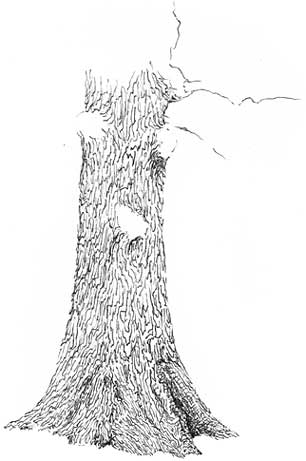 |
| Take into consideration the three dimensional view of the tree trunk. By thinking of this tree that way and not as a line on a flat piece of paper you will be able to place the line work to help build a more believable three dimensional object. After working this first section of the tree stump or trunk you will end up with an image that should reflect the first layer of tone in the trunk. You should be able to see the bark direction and the basic growth pattern in the tree. Look at WIP Image no.2 to see what I am talking about | 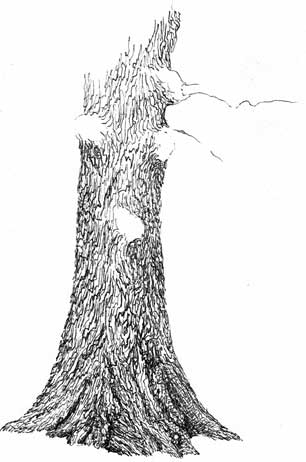 |
I continue my light tone work all the way up the main trunk and then move back down to the bottom of the trunk to start again. I keep working my way around the tree stump until I have the base worked in and then start working up the trunk again. Once the basic layout shapes and lines are in you will end up with a single tone and layer image that is a composite of the main design of the tree trunk. I then take my medium point pen and begin to work in the darker tones along the layout lines that will make up the shadowed areas in the bark work itself. The medium point pen is the best tool for this job as it is a bit broader in line. I still only use light pressure with this pen. If you go too dark at first you will be fighting to try and get the layers of value that are necessary to yield a believable three dimensional tree.
! Remember, with ball point pen it is always easier to add layers of tone than to try to remove them.
After the medium point tone layers are in you can begin to put in the small angled lines to build out the shadowed areas along the bark edges in the trunk.
! Remember, keep a consistent light source in your work.
The next layer of tone that will be used is with the medium point pen again but, is done by stipple work. This helps to build up texture and increase areas of shadow in the bark work.
Start at the bottom of the trunk at where the roots come out of the ground. Keeping in mind the shadow areas that will be cast in reference to the light source, add the quick stipple work to the tree trunk work. You won't add stipple work to the whole trunk in every area. Once the stipple work is in you will have a pretty good looking work in progress tree trunk. See images no. 3 and 4:
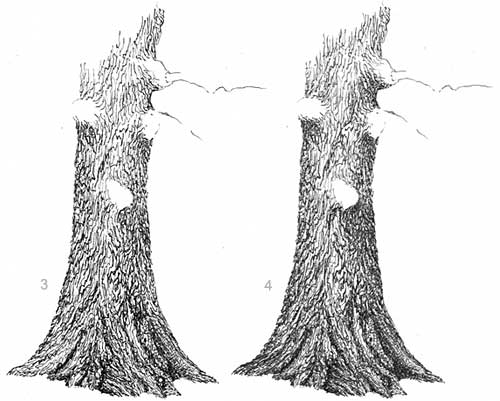
| The last layer is done with the medium point pen again. This is where you use the "Drag" method that we discussed earlier in the tutorial on the maple tree from the Gilbert home portrait.Laying the pen tip more on its side begin with a light touch and drag the tip over the area that you want to add tone to. It's a pretty quick movement and not meant to leave a distinct line rather more to leave a streak or smeared like layer of tone. You can also blend some of the ink with a blending stump or paper towel rolled tightly together and use just the very pointed tip. You don't want to overly blend any one spot though as you will begin to see a shine on the surface.The last layer of line work is done with the Fine point pen. This is where you go in and define some fine details in the bark. I find points that I want to bring out a bit more and reinforce the line that is already there. I also take this time to add any fine line light strokes that need to be added to help build the density of the object. See image no. 5: |  |
Now that we have a good start on the tree trunk, it's time to take into considerations the details that have made this Old Oak so interesting to me. The trunk has three large bumps of growth on it just below the first small branches. These are large raised, bark covered objects of growth. They are not that difficult to put in and keep the tree interesting.
Part 2 – moving on…
| Let's start by looking at how they appear in the reference photoNotice that they have a highlighted side and a shadowed side. Also, that the bark is much tighter as it works around the growth. The goal is to work your bark growth lines up to the point just below the bottom of the first growth bump. Then begin to work the lines in a very light tone from the trees left side into the center of the bump. | 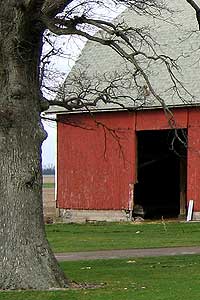 |
 | Next work the right side of the growth bump. Here is where you want to build the darker shadows that will force the highlighted portion of the bump to appear to come forward away from the rest of the trunk and bark work. I switch to the medium point pen now and go back and add the next layer of tone to the shadowed area of the bumps.You should have an image that resembles image # 6 |
From this point I work toward the first limb and branches with growth lines in the bark that lead you to them. I choose the limbs I want to render and determine which would be drawn first and if there will be any over-lapping limbs or branches. Work out to where the over-lap will be and then stop. Work the next limb or branch to and through the place of the overlap. I keep in mind my light source as I put in my shading and depth lines in each branch and limb.
| The farther up the tree you go the farther away from the viewer it will get and you will need to decrease the amount of detail in the bark lines that are seen. Make them closer together and the overall tone of the tree darker as it goes up and the branches and limb go away. Again, light layers at first make up the limbs and branches. As you put the following layers on remember your light source and keep the highlighted side lighter. You can use the drag method in the limbs and branch work to create the shadowed sides. You can see a small example of the branch and limb work in WIP image # 7 ? | 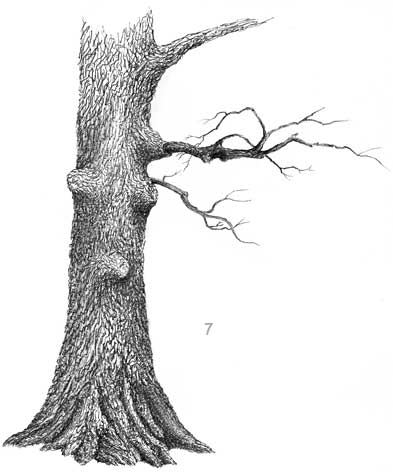 |
The next portion of the drawing work in the oak tree is to finish the limb and branch work. Using the methods that we used in the bark work, continue the line layers in the growth direction. I use light pencil lines to put in the basic direction that I want the limbs and branches to go in keeping with the reference photo. There will be less detail line work in the smaller limbs and even less to none in the smaller branches and twigs that get farther away from the viewer in the scene. This is also true just due to the size of the branches and twigs.
| Keep in mind where limbs and larger branches will over-lap and run in front or behind each other. This is also a point that you can add in cast shadows to lower branches from those above or beside. These little details help build the depth and dimension in the tree drawing itself. This is where the darker tones in the branches come in as you work up the tree. | 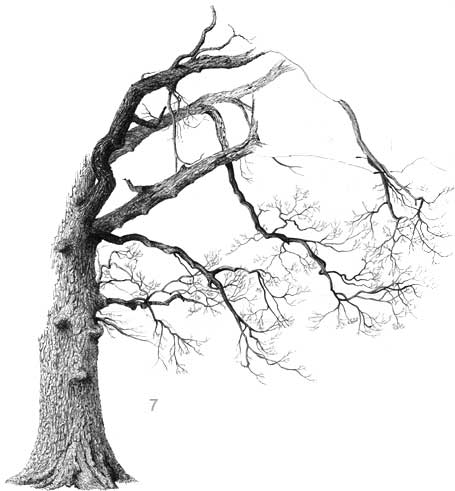 |
Remember that there are very few to no perfectly straight lines that occur in the growth of a tree in nature especially in this type of Oak tree so, as you work through the limbs and branches keep your lines flowing off the straight and flat path. Gravity and the wind have a lot to do with how a tree grows and looks in nature. Think about the weight that would be in the limbs. Show the stress of that weight in each branch as gravity tugs and pulls each one toward the ground as it struggles to grow Up and Out reaching for the sun light it needs. It's a living thing that struggles against the elements to survive. Let that struggle show in your rendering of the tree in each branch and limb.
| Then as you get to the ends of the limbs and branches notice that the twigs arch slightly upwards. This is that struggle of the tree to constantly keep itself pushing upwards to the suns rays. I love to draw these grand old trees when the foliage is gone. It allows me to show each of the turns and bends that time and the elements have brought the tree through.Each tree has a character all its own. I strive to show that character in each drawing I do.Give them life. | 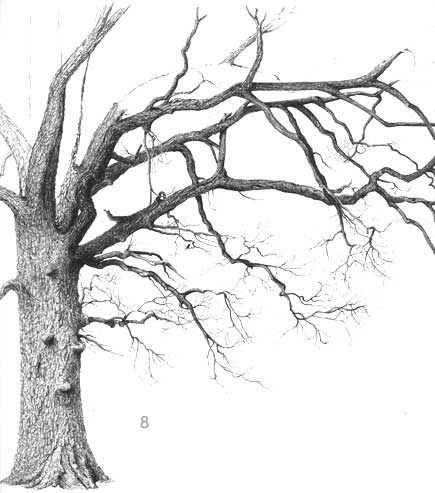 |
If you notice this last Work In Progress image, you will see that I have already added the oak's first resident… a bird resting on a branch. There will be many more of these to come before I call the drawing finished.
To finish the tree I work the rest of the limbs and branches to the edge of the page and out into the scene. The diameter of the limbs and branches get smaller as I said before, the farther away from the viewer they get and the more toward the end of the branch that they grow.
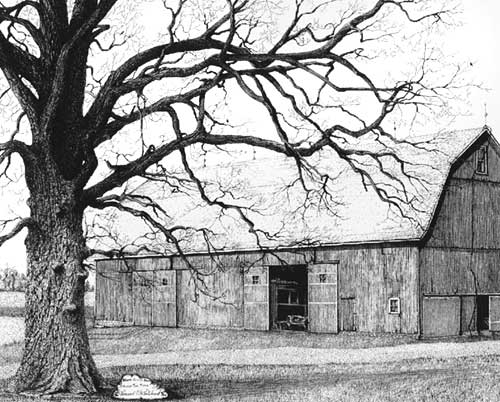
I hope that this tutorial has been and will be helpful to you to see how to render the different types of trees out there. This is in no way meant to be an exhaustive study on all trees. It is meant to help guide you as you study to develop your own skills as an artist. If you have any specific questions for me please email me and I will be happy to answer them.
Vincent D. Whitehead
"Keep On Creating!"
May 2010
shieldswitace1970.blogspot.com
Source: https://www.artinstructionblog.com/how-to-draw-an-oak-tree-step-by-step
0 Response to "How to Draw a Tree Oak Tree"
Post a Comment